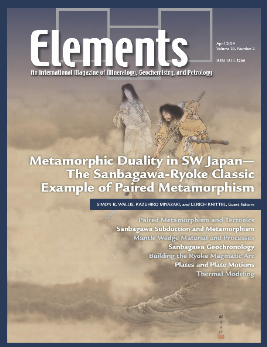April 11, 2024

Subduction, where one plate dives beneath another, controls long-term whole-Earth cycling of rocks, fluids, and energy. Plates subduct faster than they heat up, making them the coldest parts of the Earth’s interior. Fluids released from these cold plates rise into hotter overlying rocks, forming magma that feeds surface volcanism. Cold deep conditions associated with subduction complemented by hot shallow conditions under volcanic arcs are reflected in the presence of pairs of metamorphic belts, representing sites of ancient subduction. This issue of Elements guides readers through a premier example of paired metamorphism: the Cretaceous Sanbagawa-Ryoke metamorphic pair of Japan. Estimates of pressure, temperature, the age and duration of metamorphism, and the tectonic framework in which metamorphism took place help us to develop quantitative models—both for the evolution of SW Japan and subduction systems in general.
Current Geochemical Society members can access this issue now via the Elements website using your email address (UserID) and member number (Password).